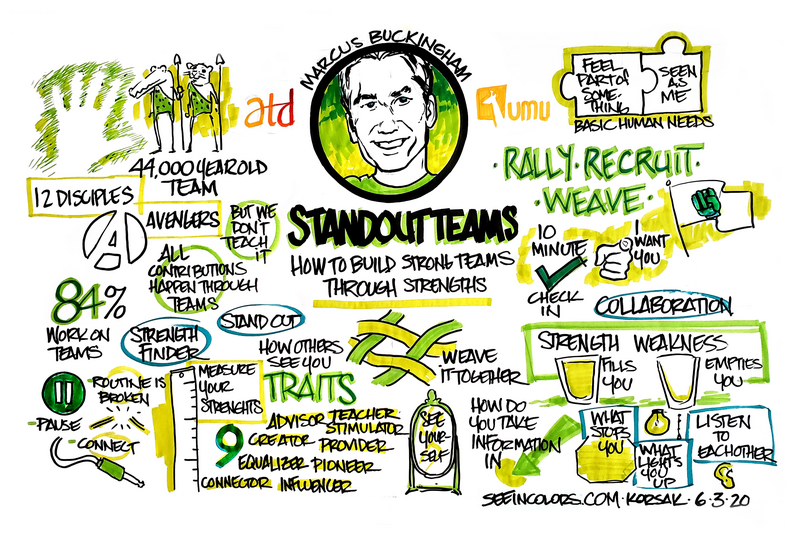ATD Blog
The Art of Team
Fri Jun 05 2020

Imagine you are a professor exploring a cave in an archipelago when you run across an old piece of art on the wall. Marcus Buckingham set the stage as he began his keynote address on the final day of the Association for Talent Development’s Virtual Conference.
He continued: You find a handprint that you subsequently determine to be about 44,000 years old. Upon further searching, you find not just a singular piece of art but a scene—it appears to be either a corralling or hunting scene with an array of people and animals. But each of the characters looks a little odd. One has a bird’s beak; the other has a crocodile snout.
But the individuals in this drawing, with all their peculiarities, came together for a purpose, one that the artwork depicts. None could complete the mission alone; they needed each member’s qualities: a cheetah’s speed, an elephant’s strength, a crocodile’s intelligence.
Buckingham—founder of the Marcus Buckingham Company—told attendees that the first piece of human art we have depicts a team.
“One of the most defining human qualities is that we are better together,” Buckingham stated succinctly. We are stronger together. We can do together so much more than we can do by ourselves.
Finding our uniqueness
Buckingham, along with the ADP Research Institute team, recently completed a 19-country study of the work setting and workplace conditions. They found that 84 percent of employees did work on teams, many of whom worked on multiple teams.
Buckingham noted that while people depict teams and write about them, the “weird thing is, we don’t teach people how to build a team, find a team, or work in teams.” To work together as a team, we first have to understand ourselves.

Sketchnotes provided by See In Colors
The Marcus Buckingham Company developed the StandOut strengths assessment, and attendees were asked to complete it in advance of Buckingham’s keynote session. The assessment helps individuals learn about and see themselves for the unique persons they are.
Buckingham said that is sorely needed in a world where we have lost so much of our sense of self, for example by losing our routines. The assessment offers nine roles. They’re not labels, Buckingham quickly noted, but doors to walk through. And while we may have characteristics of all nine roles, we don’t lead with all of them; our strength roles are about how we come across to others.
The nine roles and their associated characteristics are:
Advisor. What is the best thing to do? Advisors want to solve problems.
Connector. Whom or what can I connect? Connectors want to bring things together to make something bigger.
Creator. What do I understand? Creators make sense of the world and need quiet time to do so.
Equalizer. What is the right thing to do? Equalizers are level-headed people, seeking to keep the world in balance.
Influencer. How do I move others to action? The influencer’s power is in persuasion.
Pioneer. What’s new? What’s next? Pioneers see the world as a friendly place and are optimistic.
Provider. Are you OK? Providers are aware of each person’s emotional state and want to give them a voice.
Stimulator. How can I increase the level of excitement? Stimulators are interested in creating an emotional uptick.
Teacher. How can you learn? How can I learn? Teachers see potential in each person.
Why teams?
Buckingham noted that teams fulfill two human needs: the desire to be part of something bigger than the individual and the need to feel like we are being seen as who we are.
So, how do we build super-engaging, super-resilient, super-productive teams? How can team leaders use the strength roles and knowledge of human needs to bring out the best in their direct reports? Buckingham pointed to three ways: always be rallying, always be recruiting, and always be weaving.
Rally. To rally employees, team leaders should constantly be sharing what the team was put together to do. This isn’t about yearly goals, which are far too static for today’s reality. It must be much more timely than that.
Further, to understand how to rally their direct reports, leaders need to know their employees’ strengths roles. Because a pioneer is motivated in a different fashion than a creator, leaders need to change their language to rally those individuals. If you don’t like to change your language, Buckingham said, maybe you shouldn’t be a team leader. He continued that it’s about chess, not checkers; the players in both chess and in teams move differently.
Recruit. “I see you. I love you. I need you.” Leaders should understand the unique qualities of individuals and why those different qualities or strengths are needed on their team, Buckingham explained. Team leaders should always be recruiting their team members to stay on their team, recognizing and acknowledging their benefit.
Weave. This brings people and work together. One ritual to do that, explained Buckingham, is weekly check-ins. This frequency helps leaders understand the realities of the present work of their team members. These check-ins don’t need to be long, and leaders can do them via any modality, such as a Zoom call or text. The question they should pose is: What are your priorities, and how can I help?
Apart from that one-on-one ritual, leaders should encourage collaboration by helping team members see each other for their strengths. Buckingham outlined this exercise: Ask each employee to write down their top two strengths; have them identify the elements from the StandOut assessment report that resonated most with them; and have them record the activities at work that strengthen them—that is, put them in the state of flow—and the things that weaken them.
Buckingham offered three additional topics that employees should address to further understand themselves:
How do I best take information in (a visual, executive summary, long memo)?
“You can be sure I’ll shut down when …”
“I’ll always light up when …”
To use this information, each member should share their answers—but not simply by handing out a piece of paper to their co-workers. Buckingham said they should read their answers aloud with each of their teammates writing down the answers. That will help in active listening and give each employee a cheat sheet of sorts on each teammate, helping everyone get to know what is best about each other.
Stop to see others
These are weird times, but they’re a bit wonderful as well, Buckingham said at the start of his presentation. They’re weird because we’re all anxiously worrying about tomorrow and tomorrow and tomorrow. But they’re wonderful because we have a chance to stop and really think about those whom we care about and those we’re working closely with.
Share your ATD Virtual Conference experience on social media. #ATDVirtualConference
